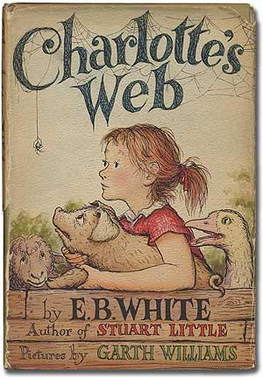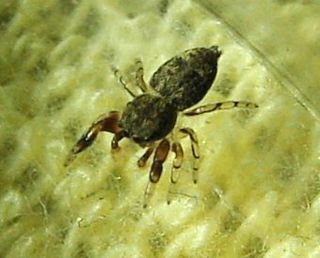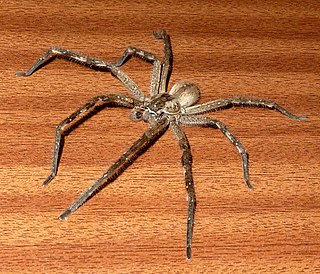
Wolf spiders are members of the family Lycosidae. They are robust and agile hunters with excellent eyesight. They live mostly in solitude, hunt alone, and usually do not spin webs. Some are opportunistic hunters, pouncing upon prey as they find it or chasing it over short distances; others wait for passing prey in or near the mouth of a burrow.

Jumping spiders are a group of spiders that constitute the family Salticidae. As of 2019, this family contained over 600 described genera and over 6,000 described species, making it the largest family of spiders at 13% of all species. Jumping spiders have some of the best vision among arthropods and use it in courtship, hunting, and navigation. Although they normally move unobtrusively and fairly slowly, most species are capable of very agile jumps, notably when hunting, but sometimes in response to sudden threats or crossing long gaps. Both their book lungs and tracheal system are well-developed, and they use both systems. Jumping spiders are generally recognized by their eye pattern. All jumping spiders have four pairs of eyes, with the anterior median pair being particularly large.

Huntsman spiders, members of the family Sparassidae, are known by this name because of their speed and mode of hunting. They are also called giant crab spiders because of their size and appearance. Larger species sometimes are referred to as wood spiders, because of their preference for woody places. In southern Africa the genus Palystes are known as rain spiders or lizard-eating spiders. Commonly, they are confused with baboon spiders from the Mygalomorphae infraorder, which are not closely related.

The Araneomorphae are an infraorder of spiders. They are distinguishable by chelicerae (fangs) that point diagonally forward and cross in a pinching action, in contrast to the Mygalomorphae, where they point straight down. Araneomorphs comprise the vast majority of living spiders.

Charlotte's Web is a book of children's literature by American author E. B. White and illustrated by Garth Williams; it was published on October 15, 1952, by Harper & Brothers. The novel tells the story of a livestock pig named Wilbur and his friendship with a barn spider named Charlotte. When Wilbur is in danger of being slaughtered by the farmer, Charlotte writes messages in her web praising Wilbur, such as "Some Pig", "Terrific", "Radiant", and "Humble", to persuade the farmer to let him live.

The redback spider, also known as the Australian black widow, is a species of highly venomous spider believed to originate in South Australia or adjacent Western Australian deserts, but now found throughout Australia, Southeast Asia and New Zealand, with colonies elsewhere outside Australia. It is a member of the cosmopolitan genus Latrodectus, the widow spiders. The adult female is easily recognised by her spherical black body with a prominent red stripe on the upper side of her abdomen and an hourglass-shaped red/orange streak on the underside. Females usually have a body length of about 10 millimetres (0.4 in), while the male is much smaller, being only 3–4 mm (0.12–0.16 in) long.

Gregory Alan Berger is an American voice actor. He is known for his roles as Jecht from Final Fantasy X and the Dissidia Final Fantasy games, Grimlock from The Transformers, Mysterio and Kraven the Hunter from Spider-Man: The Animated Series, Odie from all Garfield animated media, Cornfed Pig from Duckman, Bill Licking from The Angry Beavers, Agent Kay from Men in Black: The Series, The Gromble from Aaahh!!! Real Monsters, Captain Blue from Viewtiful Joe, Eeyore from Kingdom Hearts II, Hunter the Cheetah (1999–2002) and Ripto from Spyro the Dragon, as well as The Thing, Galactus, and Attuma from Marvel: Ultimate Alliance.

Spider-Ham is a superhero appearing in American comic books published by Marvel Comics. The character is an anthropomorphic pig and is a cartoon animal parody version of Spider-Man. He was created by Larry Hama, Tom DeFalco, and Mark Armstrong.

Ballus is a spider genus of the family Salticidae.

Cannibalism is the act of consuming another individual of the same species as food. Cannibalism is a common ecological interaction in the animal kingdom and has been recorded in more than 1,500 species. Human cannibalism is well documented, both in ancient and in recent times.

A woodlouse is any crustacean belonging to the suborder Oniscidea within the order Isopoda. They get their name from often being found in old wood, and from louse, a parasitic insect, although woodlice are neither parasitic nor insects.

Tarantulas comprise a group of large and often hairy spiders of the family Theraphosidae. As of December 2023, 1,100 species have been identified, with 166 genera. The term "tarantula" is usually used to describe members of the family Theraphosidae, although many other members of the same infraorder (Mygalomorphae) are commonly referred to as "tarantulas" or "false tarantulas". Some of the more common species have become popular in the exotic pet trade. Many New World species kept as pets have setae known as urticating hairs that can cause irritation to the skin, and in extreme cases, cause damage to the eyes.

The Makauwahi Cave is the largest limestone cave found in Hawaii. It lies on the south coast of the island of Kauaʻi, in the Māhāʻulepū Valley close to Māhāʻulepū Beach, and is important for its paleoecological and archaeological values. It is reached via a sinkhole and has been described as “…maybe the richest fossil site in the Hawaiian Islands, perhaps in the entire Pacific Island region”.

Spiders are air-breathing arthropods that have eight limbs, chelicerae with fangs generally able to inject venom, and spinnerets that extrude silk. They are the largest order of arachnids and rank seventh in total species diversity among all orders of organisms. Spiders are found worldwide on every continent except Antarctica, and have become established in nearly every land habitat. As of November 2023, 51,673 spider species in 136 families have been recorded by taxonomists. However, there has been debate among scientists about how families should be classified, with over 20 different classifications proposed since 1900.

The common rain spider, formerly P. natalius, is a species of huntsman spider native to Southern Africa. It is the most common and widespread species in the genus Palystes. In South Africa its distribution ranges from KwaZulu-Natal province in the east, then westwards to the provinces of Mpumalanga, Limpopo, Gauteng and North West in the north, and Eastern Cape and Western Cape in the south. It has a body length of 15–36 mm and a leg span of up to 110mm. The species was first described by Ludwig Carl Christian Koch in 1875.

Palystes is a genus of huntsman spiders, commonly called rain spiders or lizard-eating spiders, occurring in Africa, India, Australia, and the Pacific. The most common and widespread species is P. superciliosus, found in South Africa, home to 12 species in the genus. The name Palystes is derived from either the Latin palaestes or the Greek palaistes, meaning "wrestler". The genus was first described by Ludwig Carl Christian Koch in 1875.
Holopelus is a genus of crab spiders that was first described by Eugène Louis Simon in 1886.

Tmarus piger is a species of crab spider belonging to the family Thomisidae.
Parabomis wandae is a species of crab spider in the genus Parabomis that lives in Ghana, Ivory Coast, Kenya and Rwanda. The species was first described in 2020 by Ansie Dippenaar-Schoeman and Stefan Foord. It thrives in rainforests. The spider is very small, with a total length between 1.9 and 2.26 mm. The female is larger and lighter in colour than the male. It has a distinctive hump to the abdomen, which for the female is less pronounced. The female abdomen has dark patches and spots on its white surface, while the male has a brown shell. The species can be differentiated from other members of the genus by its copulatory organs. The male has a distinctive beak-like end of the retrolateral tibial apophysis. The female has an egg-shaped epigyne with long copulatory ducts.














